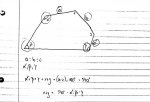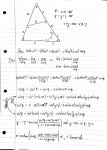Hello!
I've been bashing my head with this problem for the past couple of days and I'm starting to get the feeling there might not be a solution although my intuition tells me otherwise.
So basically I have this irregular pentagon (picture here: ) and I know all the circled parameters (angles alpha, beta and gamma and the ratio of three of its sides a:b:c). The goal here is to find the other two angles x and y.
) and I know all the circled parameters (angles alpha, beta and gamma and the ratio of three of its sides a:b:c). The goal here is to find the other two angles x and y.
I know about the sum of all internal angles of a polygon, so I know x+y=540-alpha-beta-gamma. I've forming all sorts of triangles but I never derive another connection. My 'intuition' is that once I have the initial three angles fixed (known) I cannot build the sides a, b and c with the specified ratio anywhere else apart from one place. If you don't understand the above explanation - it does not matter as that is just my reasoning that the supplied information is enough to find the unknown angles.
The solution that I derived (picture here: ) is slightly dodgy looking as I end up with x being function of only beta and alpha and I feel that can't be true. Just an explanation to what I've done - I've extended the sides to create a triangle and used law of cosines and law of sines to end up with a trigonometric equation that has only known angles, finally I combine that with the initial x+y=540-the_three_known_angles equation and solve them (using Maple) to get the dodgy result of x=f(beta, alpha).
) is slightly dodgy looking as I end up with x being function of only beta and alpha and I feel that can't be true. Just an explanation to what I've done - I've extended the sides to create a triangle and used law of cosines and law of sines to end up with a trigonometric equation that has only known angles, finally I combine that with the initial x+y=540-the_three_known_angles equation and solve them (using Maple) to get the dodgy result of x=f(beta, alpha).
Has anyone seen anything similar before? Any thoughts on my solution? Any thoughts on my 'intuition' and the fact there might not be a solution due to the lack of information given?
I've been bashing my head with this problem for the past couple of days and I'm starting to get the feeling there might not be a solution although my intuition tells me otherwise.
So basically I have this irregular pentagon (picture here:
 ) and I know all the circled parameters (angles alpha, beta and gamma and the ratio of three of its sides a:b:c). The goal here is to find the other two angles x and y.
) and I know all the circled parameters (angles alpha, beta and gamma and the ratio of three of its sides a:b:c). The goal here is to find the other two angles x and y.I know about the sum of all internal angles of a polygon, so I know x+y=540-alpha-beta-gamma. I've forming all sorts of triangles but I never derive another connection. My 'intuition' is that once I have the initial three angles fixed (known) I cannot build the sides a, b and c with the specified ratio anywhere else apart from one place. If you don't understand the above explanation - it does not matter as that is just my reasoning that the supplied information is enough to find the unknown angles.
The solution that I derived (picture here:
 ) is slightly dodgy looking as I end up with x being function of only beta and alpha and I feel that can't be true. Just an explanation to what I've done - I've extended the sides to create a triangle and used law of cosines and law of sines to end up with a trigonometric equation that has only known angles, finally I combine that with the initial x+y=540-the_three_known_angles equation and solve them (using Maple) to get the dodgy result of x=f(beta, alpha).
) is slightly dodgy looking as I end up with x being function of only beta and alpha and I feel that can't be true. Just an explanation to what I've done - I've extended the sides to create a triangle and used law of cosines and law of sines to end up with a trigonometric equation that has only known angles, finally I combine that with the initial x+y=540-the_three_known_angles equation and solve them (using Maple) to get the dodgy result of x=f(beta, alpha).Has anyone seen anything similar before? Any thoughts on my solution? Any thoughts on my 'intuition' and the fact there might not be a solution due to the lack of information given?
